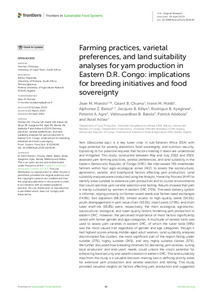| dc.contributor.author | Mondo, J. |
| dc.contributor.author | Chuma, G.B. |
| dc.contributor.author | Matiti, H.M. |
| dc.contributor.author | Balezi, A.Z. |
| dc.contributor.author | Kihye, J.B. |
| dc.contributor.author | Ayagirwe, R. |
| dc.contributor.author | Agre, A.P. |
| dc.contributor.author | Banda, V.B. |
| dc.contributor.author | Adebola, P.O. |
| dc.contributor.author | Asfaw, A. |
| dc.date.accessioned | 2024-04-08T09:23:39Z |
| dc.date.available | 2024-04-08T09:23:39Z |
| dc.date.issued | 2024-03-29 |
| dc.identifier.citation | Mondo, J., Chuma, G.B., Matiti, H.M., Balezi, A.Z., Kihye, J.B., Ayagirwe, R., ... & Asfaw, A. (2024). Farming practices, varietal preferences, and land suitability analyses for yam production in Eastern D.R. Congo: implications for breeding initiatives and food sovereignty. Frontiers in Sustainable Food Systems, 8: 1324646, 1-15. |
| dc.identifier.issn | 2571-581X |
| dc.identifier.uri | https://hdl.handle.net/20.500.12478/8460 |
| dc.description.abstract | Yam (Dioscorea spp.) is a key tuber crop in sub-Saharan Africa (SSA) with huge potential for poverty alleviation, food sovereignty, and nutrition security. Exploiting its full potential requires that factors holding it down are understood and mitigated. This study, conducted between May and July 2022 and 2023, assessed yam farming practices, varietal preferences, and land suitability in the Eastern Democratic Republic of Congo (DRC). We interviewed 765 smallholder farmers within four agro-ecological zones (AEZ) to assess the sociocultural,
agronomic, varietal, and biophysical factors affecting yam production. Land suitability analyses were conducted using the Analytic Hierarchy Process (AHP) to identify areas suitable to extensive yam production and to cluster environments that could optimize yam varietal selection and testing. Results showed that yam is mainly cultivated by women in eastern DRC (70%). The seed delivery system is informal, relying primarily on farmer-saved seeds and farmer-seed exchanges (74.9%). Soil depletion (68.3%), limited access to high-quality seeds (54.5%), youth disengagement in yam value chain (50.3%), insect pests (17.9%), and short
tuber shelf-life (65.8%) were, respectively, the main ecological, agronomic, sociocultural, biological, and tuber quality factors hindering yam production in eastern DRC. However, the perceived importance of most factors significantly varied with farmer gender and age categories. A multitude of varietal traits was used to assess yam varieties in eastern DRC, of which the tuber taste (59%) was the most valued trait regardless of gender and age categories, though it had highest scores among middle-aged adult women. Land suitability analyses
discriminated five clusters; the most significant part of the region falling under suitable (27%), highly suitable (24%), and very highly suitable classes (37%). We further discussed how breeding initiatives for delivering yam varieties, suiting local producers’ and end-users’ needs, could unlock the crop’s potential for enhancing food security and wealth creation in eastern DRC. The land suitability map from this study is a valuable decision-making tool in defining priority areas for extensive yam production and varietal selection and testing. This study
provided valuable insights on factors affecting yam production and suggested yam breeding as a backbone of a holistic approach seeking to address challenges faced in unlocking the potential for yam production in eastern DRC. |
| dc.description.sponsorship | Bill & Melinda Gates Foundation |
| dc.format.extent | 1-15 |
| dc.language.iso | en |
| dc.subject | Production Factors |
| dc.subject | Land Suitability |
| dc.subject | Breeding |
| dc.subject | Seed Systems |
| dc.subject | Food Sovereignty |
| dc.subject | Yams |
| dc.title | Farming practices, varietal preferences, and land suitability analyses for yam production in Eastern D.R. Congo: implications for breeding initiatives and food sovereignty |
| dc.type | Journal Article |
| cg.contributor.crp | Roots, Tubers and Bananas |
| cg.contributor.affiliation | Université Evangélique en Afrique |
| cg.contributor.affiliation | International Institute of Tropical Agriculture |
| cg.coverage.region | Africa |
| cg.coverage.region | West Africa |
| cg.coverage.country | Democratic Republic of the Congo |
| cg.coverage.hub | Headquarters and Western Africa Hub |
| cg.researchtheme | Biotech and Plant Breeding |
| cg.identifier.bibtexciteid | MONDO:2024 |
| cg.isijournal | ISI Journal |
| cg.authorship.types | CGIAR and developing country institute |
| cg.iitasubject | Agronomy |
| cg.iitasubject | Food Security |
| cg.iitasubject | Plant Breeding |
| cg.iitasubject | Plant Production |
| cg.journal | Frontiers in Sustainable Food Systems |
| cg.notes | Open Access Journal |
| cg.accessibilitystatus | Open Access |
| cg.reviewstatus | Peer Review |
| cg.usagerightslicense | Creative Commons Attribution 4.0 (CC BY 0.0) |
| cg.targetaudience | Scientists |
| cg.identifier.doi | https://doi.org/10.3389/fsufs.2024.1324646 |
| cg.iitaauthor.identifier | Paterne AGRE: 0000-0003-1231-2530 |
| cg.iitaauthor.identifier | Patrick Adebola: 0000-0002-5155-6194 |
| cg.iitaauthor.identifier | Asrat Asfaw: 0000-0002-4859-0631 |
| cg.futureupdate.required | No |
| cg.identifier.issue | 1324646 |
| cg.identifier.volume | 8 |

